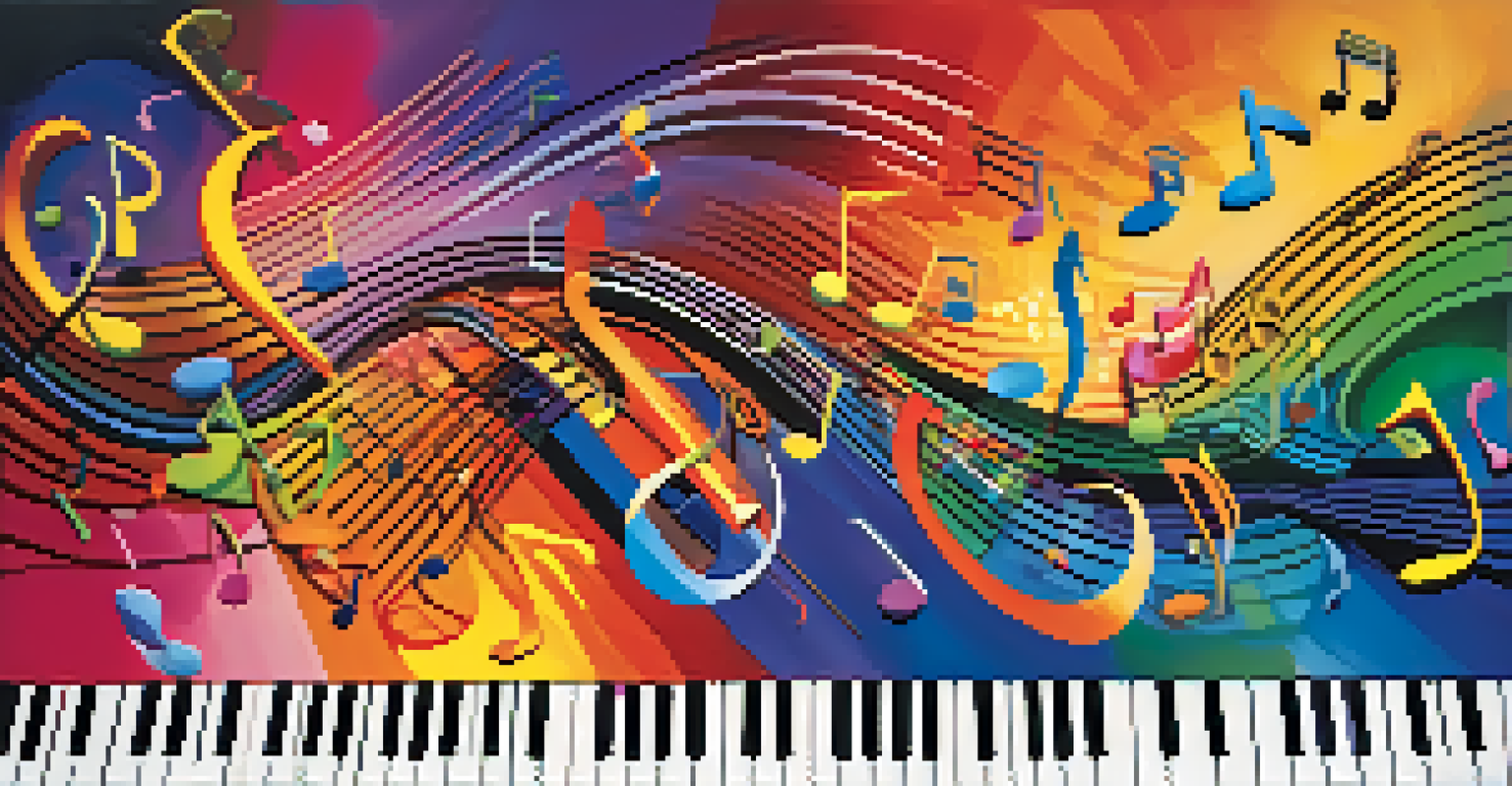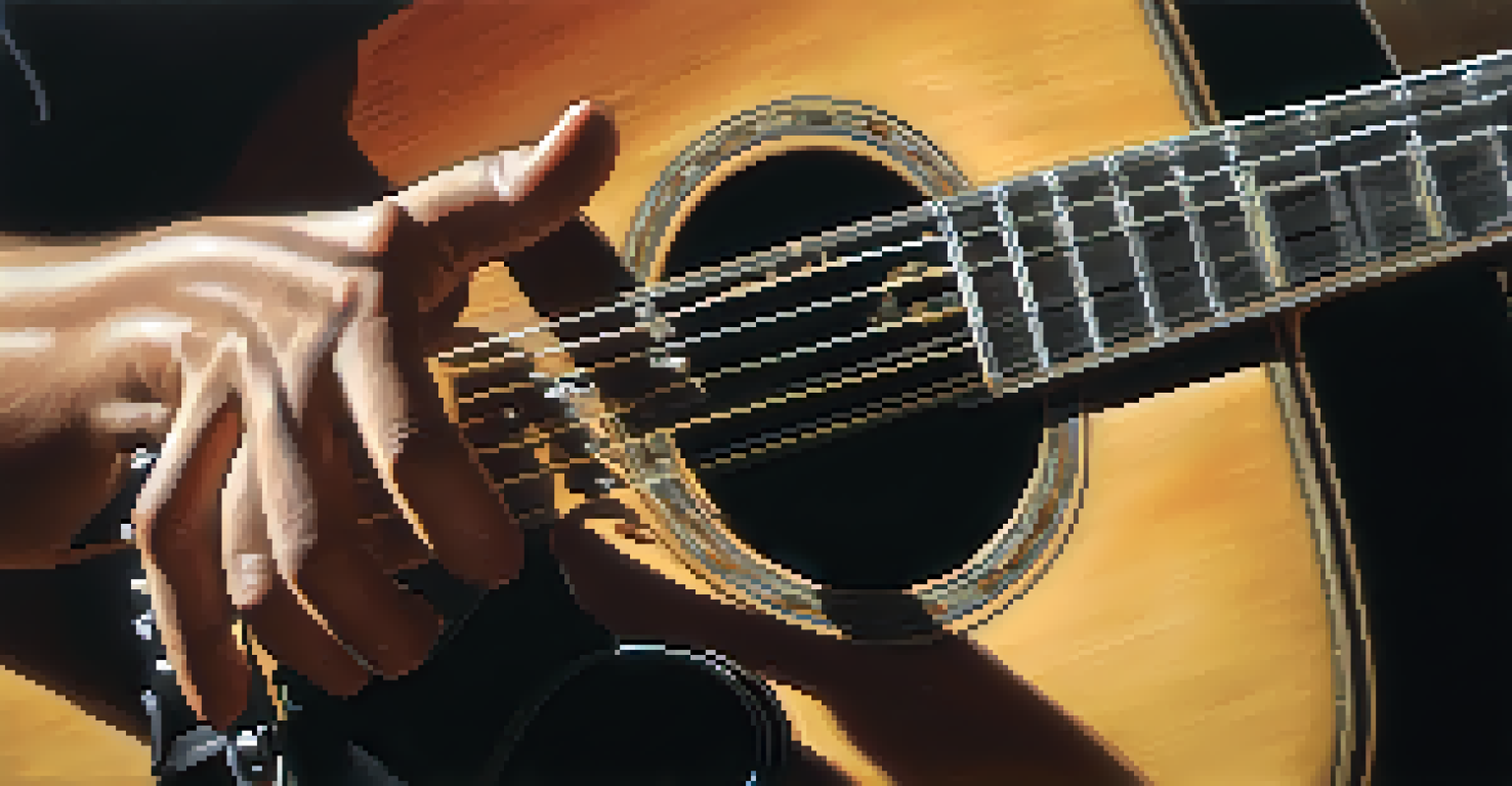The Role of Rhythm and Timing in Music Performance and Composition

Understanding Rhythm: The Heartbeat of Music
Rhythm is often described as the heartbeat of music, providing a pulse that guides performers and listeners alike. It is the structured pattern of sounds and silences that keeps the music moving forward. Think of rhythm as the framework on which melodies and harmonies hang; without it, music can feel aimless and disjointed.
Rhythm is the pulse of music; it is the heartbeat that brings life to a melody.
In practical terms, rhythm involves various elements like beats, tempo, and meter. A steady beat helps musicians synchronize their playing, while tempo dictates the speed at which a piece is performed. This interplay creates a foundation that supports the emotional expression of the music.
Ultimately, rhythm serves as a universal language in music, transcending cultural barriers. Whether it's the quick tempo of a lively dance or the slow, deliberate pace of a ballad, rhythm shapes how we experience and connect with music on a deeper level.
The Importance of Timing in Musical Expression
While rhythm sets the structure, timing adds nuance and emotional depth to musical performance. Timing refers to the precise placement of notes within the rhythmic framework, influencing how a piece feels. For instance, a slight delay or push in timing can evoke feelings of tension or release in the listener.

Musicians often manipulate timing to create subtle shifts in mood. Consider a jazz musician who plays behind the beat to add a relaxed feel or a classical pianist who uses rubato to express emotion. These techniques highlight how timing can enhance the storytelling aspect of music.
Rhythm is Music's Foundation
Rhythm acts as the structured pulse of music, guiding both performers and listeners through sound and silence.
In essence, mastering timing allows musicians to convey their unique voice and interpretation. It transforms a simple melody into a captivating experience, drawing listeners in and inviting them to feel the music on a personal level.
How Rhythm Influences Composition Techniques
When it comes to composition, rhythm acts as a powerful tool for shaping musical ideas. Composers often explore different rhythmic patterns to find the right feel for their pieces. For example, a waltz relies on a 3/4 time signature, creating a flowing, dance-like quality that is instantly recognizable.
Timing is everything in music; it is what gives the notes their meaning and emotional depth.
Experimenting with rhythm can open up new creative avenues. A composer might take a traditional melody and alter its rhythm, giving it a fresh perspective. This kind of exploration not only keeps the music engaging but also challenges the listener's expectations.
Moreover, rhythm can serve as a thematic element, providing coherence throughout a composition. By repeating specific rhythmic motifs, composers can create a sense of unity, making the music more memorable and impactful.
The Interplay Between Rhythm and Melody
Rhythm and melody are two sides of the same coin, working together to create a complete musical experience. While melody represents the tune or main theme of a piece, rhythm is what gives it structure and movement. A catchy melody paired with a compelling rhythm can make a song unforgettable.
Consider popular songs that stick in your mind; it's often the combination of a strong melody and an infectious rhythm that captures our attention. When the rhythm supports the melody effectively, it enhances the overall emotional impact and draws listeners in.
Timing Adds Emotional Depth
Mastering timing allows musicians to convey unique interpretations, transforming simple melodies into captivating experiences.
Furthermore, the relationship between rhythm and melody allows for creative innovations. Composers can play with syncopation, where the melody emphasizes off-beat rhythms, creating tension and excitement that keeps the listener engaged.
Cultural Variations in Rhythm and Timing
Different cultures have unique approaches to rhythm and timing, which can greatly influence musical styles. For instance, African music often incorporates complex polyrhythms, where multiple rhythms coexist, creating a rich tapestry of sound. This contrasts with Western music, which often emphasizes a steady beat and predictable patterns.
These cultural variations not only enrich the global music landscape but also provide musicians with a wealth of inspiration. By studying and incorporating diverse rhythmic traditions, artists can create innovative compositions that resonate with a broader audience.
Moreover, understanding these cultural differences can enhance a musician's adaptability. Being able to navigate various rhythmic styles allows performers to collaborate more effectively, bridging gaps between genres and enriching their artistic expression.
Practicing Rhythm and Timing: Tips for Musicians
For musicians looking to improve their rhythm and timing, consistent practice is key. One effective method is to use a metronome, which helps establish a steady beat and encourages precise timing. Practicing with a metronome can help musicians internalize the pulse of the music, making it easier to play in sync with others.
Another helpful technique is to break down complex rhythms into smaller, manageable parts. By isolating challenging sections and focusing on them, musicians can gradually build their confidence and proficiency. It's akin to learning a dance step; you start slow and build up speed as you become more comfortable.
Cultural Rhythms Enrich Music
Different cultural approaches to rhythm inspire musicians and enhance collaborations, creating innovative compositions.
Lastly, playing along with recordings can enhance rhythmic skills. By mimicking professional musicians, players can develop a better sense of timing and groove, ultimately translating that knowledge into their performances.
The Future of Rhythm and Timing in Music
As technology continues to evolve, so too does the way we understand and create music. Digital audio workstations and software provide musicians with innovative tools to manipulate rhythm and timing in unprecedented ways. This opens up exciting possibilities for experimentation and creativity in composition.
Moreover, the rise of artificial intelligence in music production raises questions about the role of human touch in rhythm and timing. While AI can analyze and replicate patterns, it lacks the emotional nuances that a human musician brings to a performance. This highlights the irreplaceable value of human expression in the creative process.

Looking ahead, the interplay between traditional music-making and technology promises to reshape how we perceive rhythm and timing. As musicians embrace these advancements, we can expect to see a fusion of styles and techniques that push the boundaries of musical expression.